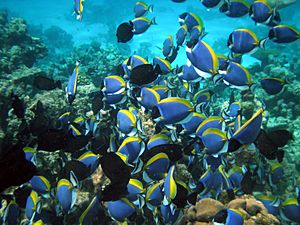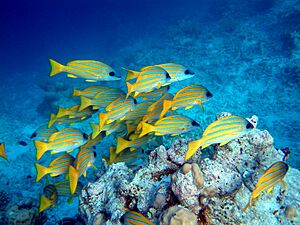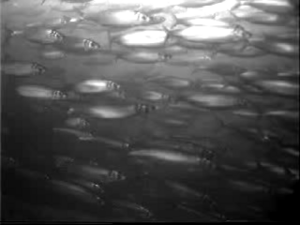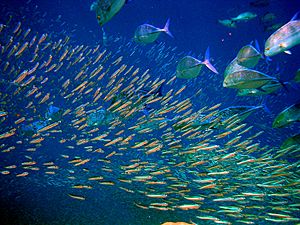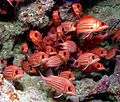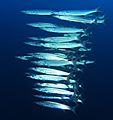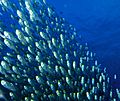Shoaling and schooling facts for kids
Schooling and shoaling are ways fish group together. It's a type of collective animal behaviour, which means animals act as a group.
When any group of fish stays together for social reasons, they are shoaling. If these fish then swim in the same direction in an organized way, they are schooling. About one-quarter of all fish species shoal their whole lives. About half of all fish species shoal for part of their lives.
Fish get many benefits from shoaling and schooling. One big benefit is protection from predators. If fish swim in schools, it's less likely that any one fish will be eaten. Grouping together can also help fish find food and even a mate. A school might even swim faster than a single fish.
Fish usually prefer to join larger groups. They also like to group with fish of their own species that are similar in size and look. Healthy fish and even family members (if they can tell who they are) are also preferred.
If a fish looks different from the rest of the group, predators might target it. This is why fish like to group with others that look like them. This idea is called the oddity effect.
What is Fish Schooling?
Some fish spend most of their lives schooling. Fish like tuna, herring, and anchovy are almost always in a shoal or school. They get upset if they are separated from their group. Other fish, like the Atlantic cod, only school some of the time.
Fish in a shoal can quickly change into a very organized school. Then, they can change back to a less organized shoal in just a few seconds. These changes happen when fish switch activities, like when they stop feeding, start resting, begin traveling, or try to avoid predators.
When schooling fish stop to eat, they often break their organized lines and become a shoal. Shoals are more at risk from predator attacks. The shape a shoal or school takes depends on the type of fish and what they are doing. Schools that are traveling might form long, thin lines, or squares, ovals, or even blob-like shapes. Fast-moving schools usually form a wedge shape. Shoals that are feeding tend to become circular.
Forage fish are small fish that are eaten by bigger fish, seabirds, and marine mammals like dolphins and whales. Small fish form schools and might swim with their mouths open to filter-feed on tiny plankton. These schools can become huge, moving along coastlines and migrating across open oceans. These large groups of fish are like big fuel stations for the ocean's top predators.
These huge gatherings of fish provide food for the entire ocean food web. Most forage fish are pelagic fish. This means they form their schools in open water, not near the bottom of the ocean. Predators are very focused on these schools. They know where the schools are and how many fish are in them. Predators often migrate thousands of miles, sometimes in their own schools, to find or stay with these forage fish.
Herring are some of the most amazing schooling fish. They gather in enormous numbers. The biggest schools often form during migrations when smaller schools join together. People have seen "chains" of mullet schools that are 100 kilometers (60 miles) long in the Caspian Sea. One expert estimated that herring schools in the North Atlantic can be as large as 4.8 cubic kilometers. This means there could be between 0.5 and 1.0 fish per cubic meter. That's about three billion fish in one school! These schools travel along coastlines and across open oceans. Herring schools have very precise arrangements that help them keep a steady swimming speed. Herrings have excellent hearing, and their schools react very quickly to predators. They keep a certain distance from a moving diver or a cruising predator like a killer whale. From a plane, this space looks like a doughnut.
Many types of large predatory fish also school. This includes many fish that travel long distances, like tuna and some ocean-going sharks. Cetaceans, such as dolphins, porpoises, and whales, also live in organized social groups called pods.
Schooling behavior is often seen as a trade-off. Fish get protection from predators, but they also have more competition for food.
Schooling is a great example of 'emergence'. This means the school has properties that individual fish don't have. These group properties give the fish in the school an advantage that single fish don't get.
How Fish Schools Avoid Predators
Fish are in danger of being eaten if they are separated from their school. Scientists have suggested several ways fish schools protect themselves from predators.
- Confusion effect – One way fish schools can trick predators is called the 'predator confusion effect'. It becomes hard for predators to pick out one fish from a large group. The many moving targets make it hard for the predator's brain to focus. Fish in a school are often the same size and silvery. This makes it difficult for a predator that hunts by sight to pick one fish out of a mass of twisting, flashing fish. The predator doesn't have enough time to grab its prey before it disappears into the group.
- Many eyes effect – Another way groups of animals protect themselves is the 'many eyes' idea. This theory says that as a group gets bigger, more individuals can help look for predators. This not only gives the group a good warning, but it also allows more time for each fish to find food.
- Dilution effect – A third idea for how fish schools avoid predators is the 'encounter dilution' effect. This is like "safety in numbers." A predator attack will eat a smaller part of a large school than a small school. This means that each fish in a large school has a lower chance of being the one eaten.
Schooling forage fish are constantly attacked by predators. A great example is the attacks that happen during the African sardine run. The African sardine run is an amazing migration of millions of silvery sardines along the southern coastline of Africa. In terms of how much living material it involves, the sardine run can be compared to East Africa's huge wildebeest migration.
Sardines have a short life cycle, living only two or three years. Adult sardines, about two years old, gather on the Agulhas Bank. They lay tens of thousands of eggs into the water during spring and summer. The adult sardines then swim in hundreds of shoals towards the warmer waters of the Indian Ocean. A larger shoal might be 7 kilometers (4 miles) long, 1.5 kilometers (1 mile) wide, and 30 meters (100 feet) deep. Huge numbers of sharks, dolphins, tuna, sailfish, Cape fur seals, and even killer whales gather and follow these shoals. This creates a huge feeding frenzy along the coastline.
When sardines feel threatened, they instinctively group together and create massive bait balls. Bait balls can be up to 20 meters (70 feet) across. They don't last long, usually less than 20 minutes.
The fish eggs left behind at the Agulhas Banks drift northwest with the ocean current. They go into waters off the west coast, where the larvae grow into young fish. When they are old enough, they gather into dense shoals and migrate south. They return to the Agulhas banks to start the cycle again.
Images for kids
-
Some coastal upwellings (red) provide plankton-rich feeding grounds for shoals of forage fish, which in turn attract larger predator fish.
-
A "tornado" of schooling barracudas
-
School of blacksmiths being cleaned by parasite eating fish
-
This copepod has its antenna spread (click to enlarge). The antenna detects the pressure wave of an approaching fish.
-
↑ A team of common bottlenose dolphins cooperate to make schooling fish jump in the air. In this vulnerable position the fish are easy prey for the dolphins.
See also
 In Spanish: Cardumen para niños
In Spanish: Cardumen para niños


